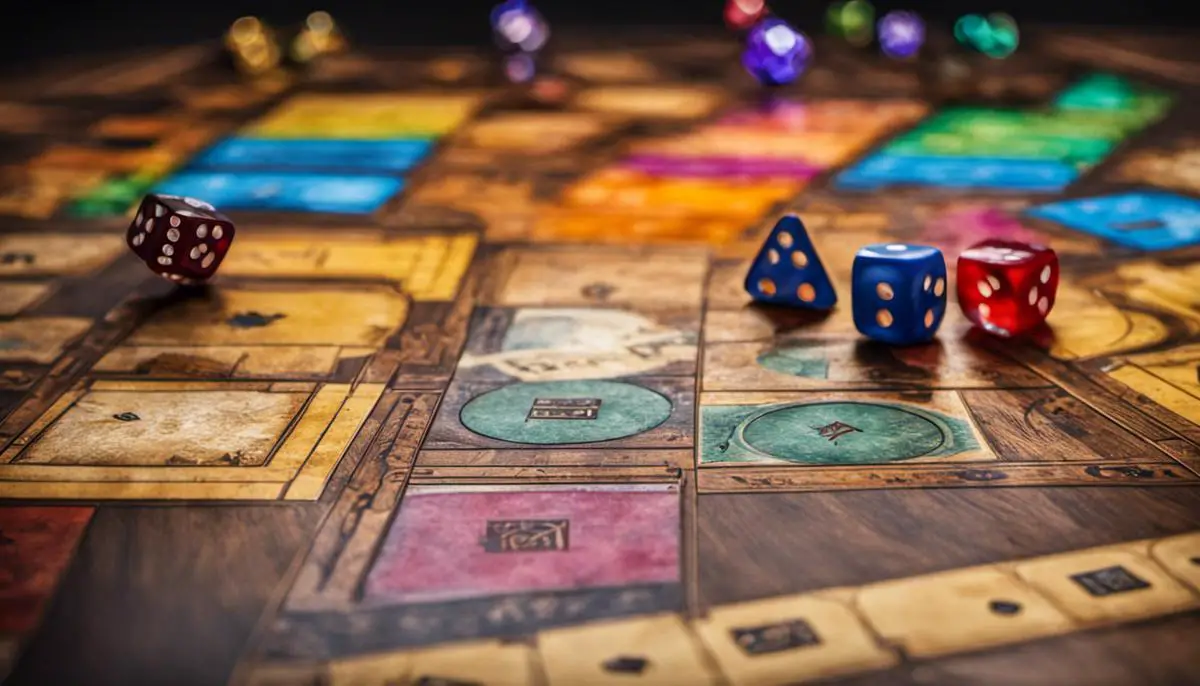The mesmerizing yet intricate game of The Castles of Burgundy tends to draw enthusiasts and hobbyists into its web of strategic deliberations and planning. Venturing beyond the surface, one can realize this game is not merely moving sheep or constructing buildings; it presents players with a canvas to craft their own medieval duchy through meticulous understanding of the game dynamics, strategic decision-making and hands-on practice. This exploratory journey infuses one with the essence of navigating through the game rules comprehensively, realizing the potential strategies at play and, finally, exposing oneself to practical experience to not just comprehend but master this intriguing game.
Understanding the Game Rules
Setup and Gameplay Overview: Preparation for a Heated Medieval Construction Match
The game Castles of Burgundy is set in the Burgundy region of high medieval France. Each player takes on the role of an aristocrat, in charge of their own expansive estate, aiming to build the greatest wealth and success through strategic construction and acquisition. The game consists of five phases played over five rounds, and each player’s score depends on their ability to efficiently and intelligently manage their estate.
To set up, each player chooses a color and collects the corresponding set of game pieces, including a player board, 2 dice, 3 worker tiles, and finally their goods, silverling, and victory points markers. The game board is set in the center of the table, with the goods tile draw pile and the five silverlings set to the side.
Possible Actions: Dicing Your Way to Dominion
Each turn, a player will roll their dice and the numbers rolled will dictate their available actions for that turn. These can include taking tiles from the depot and placing them onto their estate, or moving goods from their estate onto their own goods stack. They can also sell goods for silverlings (the game’s currency), or even spend their silverlings to buy more tiles from the middle of the board, known as the market.
Worker Tiles: Useful Tools for Die-Roll Mitigation
Worker tiles are instrumental in manipulating the results of your die roll. If a player doesn’t get the number they want, they can use a worker tile to add or subtract from their die roll, based on their strategic needs.
Buildings, Animals and More: Accumulating Value through Estate Expansion
The player board, or estate, consists of a variety of colored hexagonal spaces that represent potential construction locations. These spaces can host buildings, ships, pastures, castles and mines – the eventual sources of wealth and success. Each tile has a specific color which corresponds to the colored space where it should be placed and unique benefits. For example, animals in pastures gain Victory Points while buildings grant special abilities.
Animal tiles provide points based on the number of animals within the same pasture; in Castles of Burgundy, it’s not just about amassing the most property, but also how you manage and use it.
Game Elements: Ingredients to Medieval Success
There’s more to the game than just property! Silverling coins, represented by silver tiles, can be used to purchase new tiles. There are goods tiles, which represent goods being produced in the estate each time a player buys a ship or takes goods action. There are also victory point markers that can be scored through completing specific sections of the player board, selling goods, having leftover money, or having certain bonus tiles at the end of the game.
Ultimately, Castles of Burgundy is a game of strategy and mitigation where understanding and making the most of each and every game piece is paramount to crafting a prosperous medieval estate.

Exploring Game Strategies
Different Game Strategies for The Castles of Burgundy
Playing The Castles of Burgundy effectively requires understanding the different game strategies you can follow. The goal of the game is to get as many victory points as possible, and this can be achieved through a number of different ways.
Maximize Your Points
One way to maximize your points is to strategically build up your estate. You should consider which types of buildings to place in your estate and in which order. Plan ahead and try to control areas that complement your overall strategy. You may focus on building a large city for extra prestige points or concentrate on exploiting mines for continual income throughout the game.
Strategic Use of Workers
Another game strategy involves your workers. Workers can be instrumental in your play strategy as they can be used to adjust dice rolls, offering you more flexibility with your actions. If you find yourself unable to carry out an action due to an unfavorable dice roll, using workers to adjust the roll could potentially save your turns.
It’s recommended that you use the worker tiles wisely – remember that their supply is limited. Consider collecting more workers if you notice you are frequently unaided by your dice outcomes.
Advantages of Taking Risks
Risk-taking in The Castles of Burgundy can sometimes be advantageous. For instance, you may choose to build riskier structures like the ship or the castle. These structures might not guarantee a victory, but they allow you to make moves earlier in the next game round or provide versatile actions that can be extremely useful in certain situations.
Leverage Knowledge Section Tiles
Keep an eye out for the ‘knowledge’ section tiles. These provide different benefits and bonuses throughout the game. Some will provide benefits immediately, while others will offer points at the end of the game.
Do not ignore these tiles, as some may align remarkably well with your current strategy. For instance, the “Carpenter” tile (which scores points for buildings) pairs well if you’re focusing on city expansion.
Timing in Shipping and Trading Strategy
Shipping and trading should be done following proper timing. For instance, you may want to complete the trading action just before the storage capacity is exceeded. Additionally, try to be the first to ship your goods, as this will often grant you additional advantages and points.
Understanding different game strategies in The Castles of Burgundy is key to topping the scoreboard. Remember, there’s no one-size-fits-all strategy, so feel free to experiment with different tactics and find one that works for you.

Game Practice
Understanding the Game Components
Firstly, familiarize yourself with the different components of The Castles of Burgundy game which include different colored tiles, player mats, small tokens, and player dice. Each colored tile represents different resources or actions, such as buildings (dark green), animals (light green), ships (blue), mines (gray), and castles (dark purple). Player mats are used to construct your kingdom by placing tiles on it.
Setting Up the Game
Setup involves each player selecting a player mat and getting two dice, three workers, and one silverling (coins in the game). All tiles should be organized by color and set aside. Player tokens are then placed on the scoring track, starting at zero. The game is played over five phases, each consisting of five rounds. For each phase, tiles are placed on the corresponding numbered spaces on the game board.
Playing the Game
The game progresses as players take turns rolling their dice to perform actions. On your turn, you can perform various actions including taking a tile from the colored area matching the dice’s number, placing a tile onto your player mat onto an area with a number that matches the die used, selling goods for silverlings, and investing the workers to adjust the number on your dice.
Constructing Your Kingdom
Placing tiles onto your player mat contributes to the construction of your kingdom. Different types of tiles give unique rewards. Buildings provide bonuses, while animals provide more points the more you have of the same type. Mines generate silverlings, and ships allow you to sell goods and move up the player order track.
Scoring Points
The goal of the game is to score the most victory points. Points are scored by placing tiles, selling goods, and completing regions (areas on your player mat surrounded by a silver border) of your kingdom. The game ends at the completion of the fifth phase. After the final round, add up all the points earned throughout gameplay including bonus points from bonus tiles.
Refining the Strategy
To enhance your game play, try different strategies such as focusing on a single type of tile to maximize points, diversifying your tile types to obtain various bonuses, or concentrating on gaining many silverlings to have more flexibility in the game. Remember to pay attention to the actions of other players and adjust your strategy accordingly to block them from getting the tiles they need or to get tiles before they do.
Continuous Game Practice
Continuous practice will help you better understand the different strategies in picking, placing, and utilizing the tiles. Pay attention to what worked and what didn’t in each round. This will not only help you improve your personal strategy but will also give you insights on how to anticipate your opponent’s moves. Through consistent gameplay, you’ll begin to recognize patterns and tactics that can lead to victory in The Castles of Burgundy.

Enabling yourself to truly emerge as a skilled player of The Castles of Burgundy game goes well beyond the traditional tutorial guides. It is about immersing oneself in the game’s universe, diving deep into the ocean of various available strategies, resourcefully utilizing every tool from worker tiles to animals, and daring to experiment. The fabric of this game is spun with the yarns of strategic planning, clever risk-taking and learning from repeated game practice – each adding another layer of skillset to the player. The journey from being an enthusiast to a seasoned Castles of Burgundy player requires dedication, willingness to master the craft, and a continuous zeal of curiosity to explore the untraveled terrains of the game.
